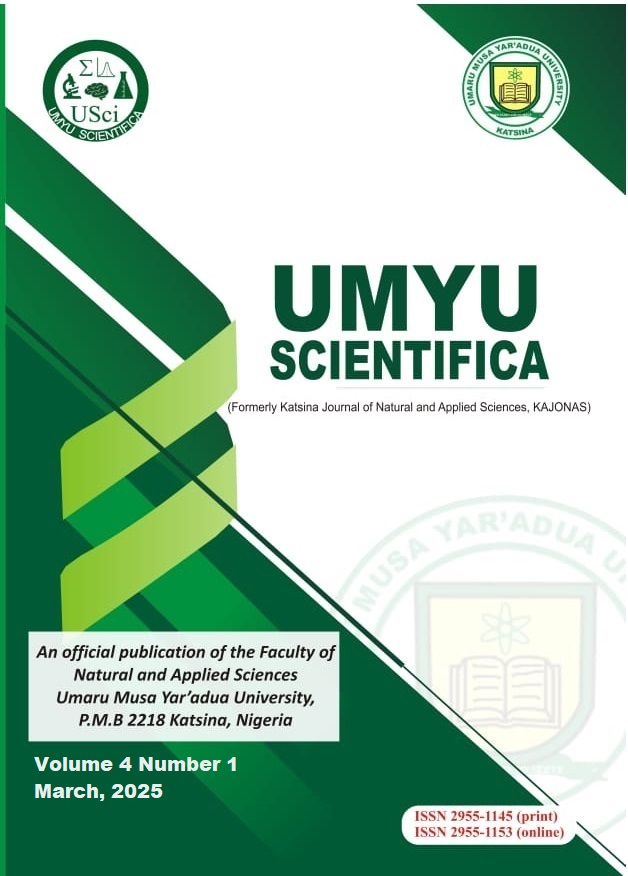Isolation and Identification of Fungal Species Associated with Post-harvest Spoilage of Onions (Allium cepa) in the Kafin Hausa Market, Jigawa State, Nigeria
Main Article Content
Abstract
Study’s Excerpt:
• This study provides a baseline inventory of fungal species associated with onion spoilage in Kafin Hausa.
• Fungal species were isolated through the direct plate method onto Potato Dextrose Agar (PDA).
• Micro- and macro-morphological techniques were used for fungal identification.
• Aspergillus niger (40.54%) and Alternaria alternata (16.22%) were the most dominant fungal species identified.
• Adoption of improved post-harvest practices such as temperature-controlled storage is advocated in mitigating possible losses.
Full Abstract:
Post-harvest fungal spoilage of onions contributes to significant global economic and food security losses, with up to 30% of harvested bulbs lost annually in developing regions. A study was conducted to isolate fungal species responsible for the spoilage of onions sold at Kafin Hausa Market, Jigawa State, Nigeria. The collected onion samples were cut into pieces of about 5 mm using a sterile razor blade, cultured on potato dextrose agar (PDA), and incubated at room temperature for 5–7 days. Fungal isolates were sub-cultured and purified onto PDA plates. Morphological identification techniques (macro- and micromorphological features) were assessed via lactophenol cotton blue staining and taxonomic keys. A total of 37 fungal isolates were obtained from 12 samples collected across 3 stations (A, B, and C). Result from the determination of frequency of occurrence show that, fungus with the highest frequency was Aspergillus niger (40.54%), followed by Alternaria alternata (16.22%), Rhizopus stolonifer (13.51%), Fusarium oxysporum (10.81%), Aspergillus flavus (8.11%), Penicillium digitatum (8.11%), and Aspergillus fumigatus (2.70%) with frequencies differing significantly across sampling stations (p < 0.05). This finding provides the first empirical documentation of onion spoilage fungi in the Kafin Hausa region of Jigawa state, Nigeria, identifying A. niger as the primary contaminant, and suggests the urgency of improved post-harvest practices (e.g., temperature-controlled storage) to mitigate losses.
Article Details

This work is licensed under a Creative Commons Attribution-NonCommercial 4.0 International License.
References
Amaechi, G., & Emmanuel, O. O. (2024). Antimicrobial Activity of Xylopia aethiopica Extract on Microorganisms Associated with the Spoilage of Vegetables in Mile 3 Market, Port Harcourt Nigeria. Microbiology Research Journal International, 34(12), 234-243. https://doi.org/10.9734/mrji/2024/v34i121524
Carvalho, T. B. de, Silva, B., Tomé, E., & Teixeira, P. (2024). Preventing Fungal Spoilage from Raw Materials to Final Product: Innovative Preservation Techniques for Fruit Fillings. Foods, 13(17), 2669. https://doi.org/10.3390/foods13172669
Diabankana, R. G. C., Frolov, M., Islamov, B., Shulga, E., Filimonova, M. N., Afordoanyi, D. M., & Validov, S. (2024). Identification and Aggressiveness of Fusarium Species Associated with Onion Bulb (Allium cepa L.) during Storage. Journal of Fungi, 10(2), 161. https://doi.org/10.3390/jof10020161
Dimkpa, S. O. N., & Onuegbu, B. A. (2010). Mycoflora of copra and effect of brining on some properties of copra in Nigeria. Agriculture and Biology Journal of North America, 1(3), 391-394. https://doi.org/10.5251/abjna.2010.1.3.391.394
El-Dawy, E. G., Hussein, M. A., & El Nahas, S. (2024). Description and management of Aspergillus section Nigri causing post-harvest bulbs rot of onion. Scientific Reports, 14(1), 6076. https://doi.org/10.1038/s41598-024-53849-9
Favour, B. A., Ulim-Ujuo-Ushang, I. P., & Adaeze, C. N. (2024). Isolation And Identification of Microorganisms from Some Spoiled Fruits and Vegetables Sold within the Federal Polytechnic of Oil and Gas Bonny Island, Rivers State. Research Journal of Food Science and Quality Control (RJFSQC) E-ISSN, 2756, 5483. https://doi.org/10.56201/rjfsqc.v10.no4.2024.pg1.9
Gathambiri, C. W. (2024). Characterization and Management of Pathogenic Fungi Contributing to Bulb Onion (Allium cepa L.) Post-harvest Rot in Kenya [Doctoral dissertation, JKUAT-CoANRE].
Guigui, H. D., Zaï, B., Coulibaly, A. S., & Dedi, J. K. (2024). Influence of Microorganisms Effective against Basal Rot and on Agronomic Parameters of Onion [Allium cepa L.(Amaryllidaceae)]. Journal of Agricultural Chemistry and Environment, 13(3), 282-299. https://doi.org/10.4236/jacen.2024.133019
Gutiérrez-Pozo, M., Verheecke-Vaessen, C., Kourmpetli, S., Terry, L. A., & Medina, A. (2024). Effect of Temperature, Relative Humidity, and Incubation Time on the Mycotoxin Production by Fusarium spp. Responsible for Dry Rot in Potato Tubers. Toxins, 16(10), 414. https://doi.org/10.3390/toxins16100414
Ikeh, M. I., Ishar, C. O., Eriobu, C. C., & Nnatuanya, I. O. (2023). Isolation and identification of fungi in onion bulbs obtained from markets in Awka metropolis, Anambra state, Nigeria. Journal of Current Biomedical Research, 3(2, March-April), 957-965. https://doi.org/10.54117/jcbr.v2i6.8
Kumar, V., Neeraj, S. S., & Sagar, N. A. (2015). Post harvest management of fungal diseases in onion-a review. International Journal of Current Microbiology and Applied Sciences, 4(6), 737-752.
Louis, M., Dela, M. E., Marie, J. O., & Pezzlo, B. T. (1997). Color Atlas of Diagnostic Microbiology. A time Company Limited.
Oluwakayode, A., Greer, B., He, Q., Sulyok, M., Meneely, J., Sulyok, M., & Medina, Á. (2024). The influence of different abiotic conditions on the concentrations of free and conjugated deoxynivalenol and zearalenone in stored wheat. Mycotoxin Research. https://doi.org/10.1007/s12550-024-00541-6
Paola, M. R. N., Lizeth, B. M. C., Athenas, S. J. T., Roberto, A. V., Cecilia, A. C. J., & Iñaky, L. A. E. (2023). Biofungicides for Management of Post-harvest Diseases. In Biofungicides: Eco-Safety and Future Trends (pp. 283-311). CRC Press. https://doi.org/10.1201/9781003287575-11
Rodrigues, B. B., Tak, A., & Kakde, U. B. (2021). Study of fungi responsible for the post-harvest deterioration of onion (Allium cepa L.). International Journal of Botany Studies, 6(3), 200-204.
Samuel, O., & Ifeanyi, O. (2015). Fungi associated with the deterioration of post-harvest onion bulbs sold in some markets in Awka, Nigeria. Bioeng Biosci, 3, 90-94. http://dx.doi.org/10.13189/bb.2015.030503
Sani, N. M., Salihu, Y., Saidu, A. Y., Yousouf, S., Nuhu, D. Z., & Rabiu, G. A. (2018). Isolation of fungi associated with the spoilage of selected vegetables sold in Dutse Ultra modern market, Jigawa state. Dutse journal of pure and applied sciences (DUJOPAS), 4(2), 349-356.
Savitha, S., Chakraborty, S., & Thorat, B. N. (2024). Inactivation kinetics of Bacillus cereus and Aspergillus niger spores in dehydrated onion shreds after pulsed light and infrared treatments. Food Production, Processing and Nutrition, 6(1). https://doi.org/10.1186/s43014-024-00242-8
Sharma, D. K. (2023). Strategies for Onion Post-Harvest Diseases Management. Asian Journal of Research in Botany, 6(2), 279-300.
Subha, S., Priyaa, H., Nisha, A., Deepika, R., & Indhumathi, G. (2024). Low Cost Cold Storage for Horticultural Produce. https://doi.org/10.59544/xwtp4969/icmtem24p3
